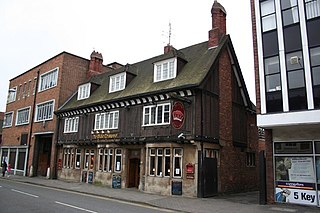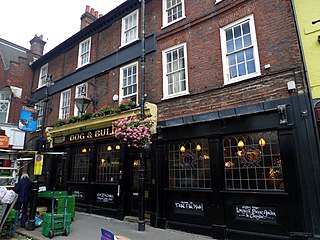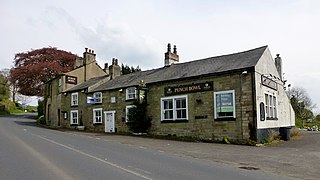
Stamford is a town and civil parish in the South Kesteven district of Lincolnshire, England. The population at the 2011 census was 19,701 and estimated at 20,645 in 2019. The town has 17th- and 18th-century stone buildings, older timber-framed buildings and five medieval parish churches. It is a frequent film location. In 2013 it was rated a top place to live in a survey by The Sunday Times. Its name has been passed on to Stamford, Connecticut, founded in 1641.

Geno Washington is an American R&B singer who released five albums with the Ram Jam Band between 1966 and 1969, and eight solo albums beginning in 1976.

Bottesford is a village and civil parish in the Borough of Melton in the ceremonial county of Leicestershire, England. It lies close to the borders of Nottinghamshire and Lincolnshire.

Stretton is a village and civil parish in the county of Rutland, England, just off the A1 Great North Road. The population of the civil parish was 770 at the 2001 census, including Thistleton and increasing to 1,260 at the 2011 census. The ecclesiastical parish of Stretton shares the same boundaries and is part of the Rutland deanery of the diocese of Peterborough.

Great Casterton is a village and civil parish in the county of Rutland in England. It is located at the crossing of the Roman Ermine Street and the River Gwash.

Pub names are used to identify and differentiate traditional drinking establishments. Many pubs are centuries old, and were named at a time when most of their customers were illiterate, but could recognise pub signs. The use of signage was not confined to drinking establishments. British pubs may be named after and depict anything from everyday objects, to sovereigns, aristocrats and landowners. Other names come from historic events, livery companies, occupations, sports, and craftsmen's guilds. One of the most common pub names is the Red Lion. This list contains both modern and historical examples.

Ketton is a village and civil parish in Rutland in the East Midlands of England. It is about 8 miles (13 km) east of Oakham and 3 miles (5 km) west of Stamford, Lincolnshire. The 2011 Census recorded a parish population of 1,926, making it the fourth largest settlement in Rutland, after Oakham, Uppingham and Cottesmore. The village has a primary school.

South Luffenham is a village in the county of Rutland in the East Midlands of England. The population of the civil parish was 470 in 2021 increasing from 455 at the 2011 census.

The Great North Road was the main highway between England and Scotland from medieval times until the 20th century. It became a coaching route used by mail coaches travelling between London, York and Edinburgh. The modern A1 mainly parallels the route of the Great North Road. Coaching inns, many of which survive, were staging posts providing accommodation, stabling for horses and replacement mounts. Nowadays virtually no surviving coaching inns can be seen while driving on the A1, because the modern route bypasses the towns in which the inns are found.

South Witham is a village and civil parish in the South Kesteven district of Lincolnshire, England. The population of the civil parish at the 2011 census was 1,533. It is situated 10 miles (16 km) south of Grantham, 10 miles east of Melton Mowbray and 10 miles (16 km) north of Oakham. The village is close to the Leicestershire and Rutland borders.

Castle Bytham is a village and civil parish of around 300 houses in South Kesteven, Lincolnshire, England. It is located 9 miles (14 km) north of Stamford and 9 miles (14 km) west of Bourne. The population was measured at 768 in 317 households at the 2011 census.
The pubs and inns in Grantham reflect to a great extent the history of the town, soke, and Parliamentary constituency of Grantham, Lincolnshire, England.
Geno Washington & the Ram Jam Band are an England-based soul band.
Peter Gage is an English rock guitarist, pianist, composer and record producer, best known for his work with Geno Washington & the Ram Jam Band and Vinegar Joe.

The Tumbledown Dick was a former public house in Farnborough, Hampshire, England, that operated from the 16th century until the early 21st century. The name of the pub originates as the satirical nickname given to Richard Cromwell, son of Oliver Cromwell, after his abrupt fall from power after a brief nine-month reign in 1658–59. The pub was the central focus of Farnborough before its 19th-century refocus toward North Camp and the current town centre's 20th-century development. Local folklore links the pub with various historical figures, including Cromwell, Henry VII and Dick Turpin. The pub was closed in 2008, and the building was purchased by McDonald's in 2012.

Traylen and Lenton was an architectural practice in Stamford, Lincolnshire. The practice had offices at 16 Broad Street, Stamford and were the successors to a line of architects working in Stamford, starting in the 1830s with Bryan Browning and continued by his son Edward Browning. The Brownings' practice was purchased by John Charles Traylen in 1888. Henry Francis Traylen became a partner in the practice and sole proprietor after his father's death in 1907. Frederick James Lenton worked as his assistant from 1908 until he became a partner in the practice with Traylen in 1921/2. The partnership had offices in Newark, Grantham and Peterborough, as well as Stamford.
Brian Thompson (1938–2011) was an English goalkeeper, who played for Grantham Town, Loughborough and Peterborough United.

The Dog & Bull is a public house in Croydon, England. It is a Grade II listed, 18th-century building with a 19th-century frontage in Surrey Street, on the site of a previous 12th- or 13th-century inn called The Bell.

The Punch Bowl Inn was an 18th-century Grade II-listed public house in Hurst Green, Ribble Valley, Lancashire, England. It consisted of a number of independent buildings, including what were originally two cottages and a barn, and a 19th-century extension. The pub was reputed to be haunted by the ghost of a highwayman. The pub closed in 2012 and afterwards stood empty. It was demolished in June 2021 without the required planning permission and an investigation followed, leading Ribble Valley Council to instruct the owners to rebuild it.
















